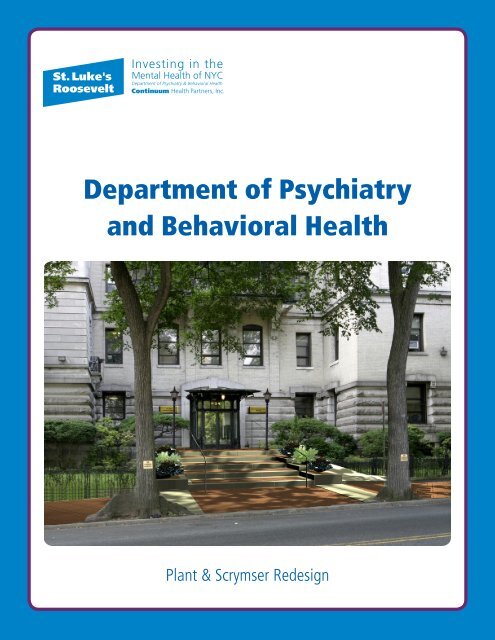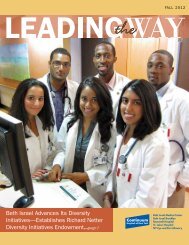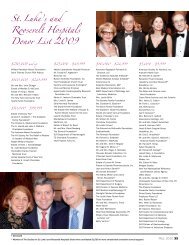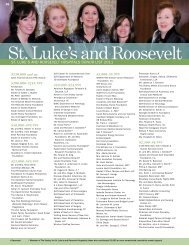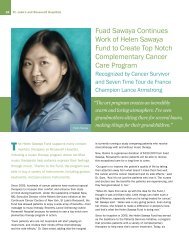Learn more about this project. - Support St. Lukes Roosevelt
Learn more about this project. - Support St. Lukes Roosevelt
Learn more about this project. - Support St. Lukes Roosevelt
You also want an ePaper? Increase the reach of your titles
YUMPU automatically turns print PDFs into web optimized ePapers that Google loves.
Department of Psychiatry<br />
and Behavioral Health<br />
Plant & Scrymser Redesign
The landmark Global Burden of Disease <strong>St</strong>udy found that—globally—4 of the 6<br />
leading causes of disability are treatable psychiatric disorders (depression, alcoholuse<br />
disorders, schizophrenia and bipolar disorder). This statistic is not just <strong>about</strong><br />
“them,” because mental health problems, including addictions, affect all of us<br />
The burden of mental health disorders, in addition to the<br />
direct cost of treatment (estimated at over $66 billion), has<br />
extraordinary social and economic costs.<br />
1 in 4 families<br />
has at least one<br />
member with a<br />
mental disorder.<br />
• Family care responsibilities and discrimination that<br />
impacts quality of life<br />
• Disruption of education and careers with onset of<br />
mental disorders<br />
• Absenteeism and lost productivity at work<br />
• 59% of the costs of injury or illness-related loss of<br />
productivity is due to mental illness – that’s $193.2<br />
billion in lost earnings per year in the US!
“There is no health without mental health.”<br />
-David Satcher, MD, Former Surgeon General of the United <strong>St</strong>ates<br />
Mental disorders are highly interrelated with medical illness and<br />
they impact each other:<br />
• Mental disorders increase the risk of having medical problems.<br />
• Having a chronic medical disease increases the risk of having a mental disorder.<br />
• People with chronic medical problems fare worse in the context of mental disorders.<br />
This may be because:<br />
• People with medical diseases often have mental disorders that are under-recognized, and<br />
not always treated effectively.<br />
• People with mental disorders may not adhere as well to their treatment schedules for<br />
physical disorders.<br />
• People with severe mental disorders are less likely to get appropriate medical services. 60%<br />
of Americans with a mental disorder get no treatment at all for their ailment.<br />
Mental illness is a common, pervasive and critical public<br />
health and economic problem. Is there any good news<br />
in all of <strong>this</strong>?<br />
Yes. Treatment works, and reduces the social and economic burden.<br />
Medical research has provided evidence that psychological factors can play a major role in<br />
illnesses, and that behavioral health services are an important component of overall care.<br />
• Along with heart disease, cancer, trauma, and osteoarthritis, mental disorders are among the<br />
five most costly medical conditions.<br />
• Treating mental illness with effective interventions not only improves quality of life, but improves<br />
overall medical outcomes, and reduces disability.
Our Background<br />
<strong>St</strong>. Luke’s <strong>Roosevelt</strong> Hospital Center is<br />
affiliated with Columbia University College<br />
of Physicians and Surgeons. Founded by a<br />
merger in 1979, The <strong>St</strong>. Luke’s site is located<br />
on Amsterdam Avenue and 114th <strong>St</strong>reet and<br />
the <strong>Roosevelt</strong> site is located on 59th and<br />
10th Avenue. <strong>St</strong>. Luke’s <strong>Roosevelt</strong> Hospital<br />
Center reaches out to medically underserved<br />
communities in surrounding Manhattan<br />
neighborhoods through partnerships with<br />
community based organizations, health<br />
centers, school-based clinics, and other<br />
community groups. As a non-profit and<br />
owned by Continuum Health Partners,<br />
<strong>St</strong>. Luke’s <strong>Roosevelt</strong> Hospital Center is<br />
governed by its own Board of Trustees.<br />
Through Continuum Health Partners,<br />
<strong>St</strong>. Luke’s <strong>Roosevelt</strong> Hospital Center is<br />
affiliated with Beth Israel Medical Center,<br />
and New York Eye & Ear Infirmary.<br />
The Department of Psychiatry and Behavioral<br />
Health at <strong>St</strong>. Luke’s <strong>Roosevelt</strong> Hospital<br />
was founded in 1954. During <strong>this</strong> time<br />
the Mental Health Act of 1959 was passed<br />
and long-term psychiatric inpatient care<br />
began declining with a national agenda to<br />
provide humane care within communities.<br />
With a commitment to the full and healthy<br />
lives of all New Yorkers, over the last 50<br />
years the Department of Psychiatry and<br />
Behavioral Health has grown to provide over<br />
35 programs recognized nationally for their<br />
excellence especially in the areas of addiction<br />
medicine and community psychiatry.<br />
Original 113th <strong>St</strong>reet entrance to <strong>St</strong>. Luke’s Hospital
Our Mission<br />
The mission of our Department of Psychiatry and Behavioral Health has remained unwavering and<br />
is threefold, encompassing excellence in service, teaching and advancing our knowledge through<br />
cutting edge research. Our mission is to provide outstanding health care and to meet the mental<br />
health needs of New York City.<br />
<strong>St</strong>. Luke’s and <strong>Roosevelt</strong> Hospitals are dedicated to providing the very best in behavioral health<br />
services, geared to people in the community they live in. We provide comprehensive, high-quality<br />
services, which empower individuals to change their lives.<br />
• We effect change in our neighborhoods through consumer education, outreach and<br />
community collaboration.<br />
• We shape the future through leading-edge research and the development of skilled<br />
professional staff to help serve individuals and their community.<br />
• Through our accredited internship, residency training, and fellowship programs, we<br />
contribute both locally and nationally to our mental health resources.<br />
Every year we provide over 185,000 patient care visits<br />
to community members across the life span from infancy to elder<br />
care. We reach thousands <strong>more</strong> through our delivery of workshops<br />
and talks both within the hospital and outside of its walls.
Our Programs<br />
The Child and Family Institute (CFI) provides a full range of<br />
child and adolescent psychiatric treatment programs, which meet<br />
the needs of a diverse community, while maintaining state-of-theart<br />
treatment and quality assurance. CFI supports resilience by delivering a continuum of services<br />
including outpatient and school-based day programs, home and community based services,<br />
blended case management, as well as crisis intervention and home-based services to prevent<br />
hospitalizations. CFI is also committed to training a broad range of community-minded child and<br />
adolescent clinicians, from Child and Adolescent Psychiatrists to marriage and family therapists.<br />
Within its portfolio, CFI is also active in leading clinical research activities. CFI’s Outpatient Clinic<br />
will be housed within Plant & Scrymser.<br />
The Addiction Institute of New York (AINY) is a world-renowned<br />
addiction treatment center: a comprehensive treatment, education, and<br />
research magnet, specializing in the care of people with substance use<br />
and co-occurring psychiatric disorders. It focuses on individualized care,<br />
including inpatient, outpatient, residential services, opioid treatment, a<br />
day program for adolescents, and consultation to medical and surgical units. AINY is the premier<br />
addiction research and teaching site for Columbia University. It will contribute its Trinity House and<br />
Women’s Health Project programs to Plant & Scrymser. A unique and critical community service<br />
that Trinity House provides is the Connect Program for young women and their children. The<br />
Women’s Health Project provides treatment for women who have been victims of crimes, trauma,<br />
or abuse and who suffer from addictions.<br />
The Division of Outpatient & Community Psychiatry<br />
(DOC) is comprised of adult outpatient programs and<br />
community-based psychiatric services. It assists people in<br />
optimizing personal recovery and actively connects them<br />
with community resources. In addition to hospital clinic<br />
services, DOC provides community-based service at an<br />
outpatient clinic satellite provides psychiatric staffing to local<br />
community-based organizations. DOC programs involved in<br />
<strong>this</strong> <strong>project</strong>: The Psychiatric Recovery Center (PRC), The Adult<br />
Outpatient Clinic (OPC), and Primary Care Services.<br />
“I am a woman 43 years<br />
of age and I suffer from<br />
anxiety, depression and<br />
schizophrenia. Coming<br />
to a program has been<br />
important to my treatment<br />
and progress. Without the<br />
support and network of the<br />
treatment team, I would be<br />
lost.” -- Maria L.
The Future<br />
Advances in medicine have made it possible to<br />
deinstitutionalize mental health care for severely<br />
ill individuals and to treat on an outpatient basis<br />
patients who can now live in their communities,<br />
attend school, work and live healthier lives.<br />
Unfortunately, stigma <strong>about</strong> receiving mental<br />
health services, let alone addiction services still<br />
presents a major obstacle in access to care for<br />
many. Both the integration of health with mental<br />
health care and expanding our roots in the<br />
community are vital in our future delivery of care.<br />
With <strong>this</strong> in mind, our plans for Plant & Scrymser<br />
are to:<br />
1. Integrate primary health care with our mental<br />
health services<br />
2. Increase our evidence based care, becoming a<br />
premier site for communities in need.<br />
3. Continue our mission of excellence in teaching<br />
and training<br />
Side view showing architectural details of<br />
The Margaret J. Plant Pavilion<br />
*2002 NYCLPC Landmark Designation Report<br />
4. Advance the field of psychiatry with research specifically targeting co-occurring disorders, early<br />
on-set psychosis and childhood trauma.<br />
We will accomplish <strong>this</strong> by filling six of the existing eight floors of Plant & Scrymser with our<br />
transformed clinical services. Our goal is to collaborate with existing <strong>St</strong>. Luke’s <strong>Roosevelt</strong> Hospital<br />
Center primary and specialty care programs and our community partners to offer innovative,<br />
evidenced based care. Our informatics infrastructure will support an electronic medical record<br />
available to clinicians of all disciplines working with each patient. We will utilize state of the art<br />
technologies in telemedicine and offer comprehensive care on-site with roots into the community.<br />
Our family friendly site will be welcoming to all cultures, and fill a need on the Upper West Side for<br />
enhanced mental health services. Educational programs on-site will reach family and community<br />
members struggling to understand addiction and mental illness while also addressing wellness<br />
and complimentary medicine. Research and evaluation of our programs will be integrated and<br />
seamless—part of the fabric of what will make <strong>this</strong> <strong>project</strong> a model for the New York <strong>St</strong>ate and<br />
the nation.
Plant & Scrymser: 21st Century Care in a 19th Century-<strong>St</strong>yled Home<br />
Designated as NYC Landmarks in the historic Morningside Heights, the Plant and Scrymser<br />
pavilions were designed by Beaux-Arts trained architect Ernest Flagg. The construction of both<br />
historic buildings on <strong>St</strong>. Luke’s Hospital campus were funded through the generosity of individuals<br />
committed to making an impact on health care of their fellow New Yorkers. Margaret J. Plant,<br />
widow of Henry Bradley Plant (1819-1899), became a major philanthropist with the inheritance<br />
of her husband’s fortune earned from railroads, steamship lines and hotels. She financed the Plant<br />
Pavilion, dedicated in 1906. The Scrymser Pavilion, completed in 1928, was named for James<br />
Alexander Scrymser, a pioneer in the development of telegraph cable lines, whose legacy of <strong>more</strong><br />
than one million dollars was received by the hospital after his widow, Mary Catherine passed<br />
away.<br />
Originally built to house private patients allowing for spacious rooms with views of beautiful<br />
Morningside Park, today Plant & Scrymser represent a powerful opportunity for transformation<br />
of clinical care within reach of all New Yorkers. These handsome buildings are clad in rusticated<br />
stone and buff-colored brick, with mansard roofs. The Plant Pavilion in French Renaissance Revival<br />
style, has marble and granite through the two lowest stories and light pressed brick and terra<br />
cotta above.*<br />
These buildings provide a unique philanthropic opportunity in which to support preserving the rich<br />
architectural legacy of New York while serving the medical mission of <strong>St</strong>. Luke’s Hospital.
Funding Opportunity<br />
<strong>St</strong>. Luke’s and <strong>Roosevelt</strong> Hospitals is embarking on a $20 million <strong>project</strong> to renovate and relocate<br />
all programs into one building in an effort to consolidate services and enhance access to care for<br />
patients. The hospitals have committed $15 million and we seek an additional $5 million to reach<br />
our goal. In addition to the necessary structural work to make the space functional for patient<br />
services, we are striving to provide our clients with an inviting and dignifying space in which they<br />
receive their care. Examples include:<br />
• Reinforce and enclose our balconies with glass to preserve the breathtaking park views,<br />
offering clients a calm, beautiful waiting area in a space that would otherwise remain unused.<br />
• Beautify the space to make it inviting and comfortable for all members of the community<br />
that come to us for treatment.<br />
Our vision is to create a distinctly non-institutional<br />
environment for patients and families receiving services.<br />
For further information, please reach out to:<br />
Richard N. Rosenthal, MD, Chairman (212) 523-5366<br />
David Wyman, Assistant Vice President (212) 523-5643<br />
Miriam Martinez, PhD, Chief <strong>St</strong>rategic Initiatives (212) 523-2025<br />
Susan Fenton, Director, Special Projects (212) 523-7342


